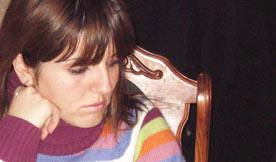
A STORY OF A VILLAGE
The spring of 1994 was especially fixed in my memory because the brightest memories of my childhood are related to it. I will never forget the impressions related to my arrival at the village. It was May, the sky was cloudless and the rays of the spring sun warmed not only the nature but also my soul. Apple gardens blossomed and the soft aroma of flowers spread in the air. I was frightened of walking on the path so as not to step on the many - coloured “rug” of flowers accidentally. In other words, I have never seen such a beautiful scene anywhere. In the meantime, the days were passing …
Suddenly, the sunny weather changed into a rainy one. It looked like the rain would never stop. I was very bored. I approached my grandmother and asked her a question: “Granny, why is it always raining over here?” My granny looked at me with sadness and pain and answered: “It is the nature that is crying for former inhabitants of the village…” And then I learnt that Azerbaijanians lived in this small village Kizil-Shafag which was located in Tashir region during the Soviet Union and was long forgotten by everybody.
In 1988 the village was transformed. The dwellers deserted it and which was then inhabited by Armenians from Baku, Shemakh, Kerkencha. Kizil-Shafag was renamed to Dzunashakh. Everything I heard that day interested me ever so much. But there existed one more undisclosed mystery. I stood for hours at the gates of my house. My attention was drawn to the neighbouring village with endless numbers of houses. Green fields formed the border between the villages. I was looking into the distance. And I was wondering to know who was living over there, what they were engaged in …
Everything cleared up in the haymaking season. When I went into the house and heard an unintelligible speech. I greeted and received an answer back in my native language. It amazed me very much. I took a seat and began watching very carefully. The conversation resumed. Some time later the guest left the place and arranged about something with the grandfather. (Later on I learnt that they were discussing the problems with haymaking. As it very often happened the neighbours come to the assistance of one another). After the guest had left, I asked my granny numerous questions …
“Dzunashakh is a symbol of friendship of two nations which are at enmity” – she said at the time.
Ani Martirosyan
student of RAU
Master-class of Alekper Aliyev
22-02-07
Suddenly, the sunny weather changed into a rainy one. It looked like the rain would never stop. I was very bored. I approached my grandmother and asked her a question: “Granny, why is it always raining over here?” My granny looked at me with sadness and pain and answered: “It is the nature that is crying for former inhabitants of the village…” And then I learnt that Azerbaijanians lived in this small village Kizil-Shafag which was located in Tashir region during the Soviet Union and was long forgotten by everybody.
In 1988 the village was transformed. The dwellers deserted it and which was then inhabited by Armenians from Baku, Shemakh, Kerkencha. Kizil-Shafag was renamed to Dzunashakh. Everything I heard that day interested me ever so much. But there existed one more undisclosed mystery. I stood for hours at the gates of my house. My attention was drawn to the neighbouring village with endless numbers of houses. Green fields formed the border between the villages. I was looking into the distance. And I was wondering to know who was living over there, what they were engaged in …
Everything cleared up in the haymaking season. When I went into the house and heard an unintelligible speech. I greeted and received an answer back in my native language. It amazed me very much. I took a seat and began watching very carefully. The conversation resumed. Some time later the guest left the place and arranged about something with the grandfather. (Later on I learnt that they were discussing the problems with haymaking. As it very often happened the neighbours come to the assistance of one another). After the guest had left, I asked my granny numerous questions …
“Dzunashakh is a symbol of friendship of two nations which are at enmity” – she said at the time.
Ani Martirosyan
student of RAU
Master-class of Alekper Aliyev
22-02-07
